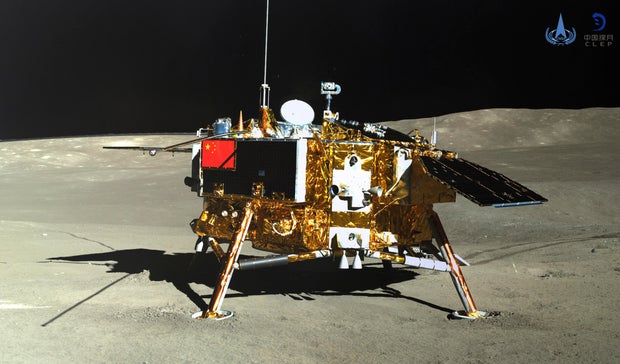Beijing – China said its lunar spacecraft unfurled the country’s red and gold flag for the first time on the far side of the Moon, before part of the vehicle lifted off on Tuesday morning with rock and soil samples to bring back to Earth. The mission was hailed as a success in China, which has made significant advances in a space program that aims to put a person on the Moon before the end of this decade.
O Chang’e-6 probe was launched last month and its lander touched down on the far side of the moon on Sunday. Its lift took off on Tuesday morning at 7:38 a.m. Beijing time, with its engine running for about six minutes as it entered a predefined orbit around the Moon, the China National Space Administration said.
The agency said the spacecraft withstood a high-temperature test on the lunar surface and acquired the samples using drilling and surface collection before storing them in a container inside the probe’s elevator, as planned.
The container will be transferred to a reentry capsule that is expected to return to Earth in the deserts of China’s Inner Mongolia region around June 25.
Reuters/CCTV
The small flag, which the agency said was made of special composite materials, appeared on a retractable arm deployed on the side of the lunar module and was not placed on the lunar soil, according to an animation of the mission released by the agency.
“Mission Accomplished!” Foreign Ministry spokeswoman Hua Chunying wrote in X. “An unprecedented feat in the history of human lunar exploration!”
Missions to the far side of the Moon are more difficult because it is not facing Earth, requiring a relay satellite to maintain communications. The terrain is also more rugged, with fewer flat areas to land on.
Xinhua said the probe’s landing site was the South Pole-Aitken Basin, an impact crater created more than 4 billion years ago, 13 kilometers deep and with a diameter of 2,400 kilometers.
It is the oldest and largest such crater on the Moon, so it could provide the first information about it, Xinhua said, adding that the huge impact may have ejected materials from deep beneath the surface.
The mission is the sixth in the Chang’e lunar exploration program, which is named after a Chinese lunar goddess. It is the second designed to bring back samples, after Chang’e 5, which did so from the near side in 2020.
China National Space Administration/Xinhua News Agency via AP
The lunar program is part of a growing rivalry with the US – still a leader in space exploration – and others, including Japan and India. China currently has a three member crew on its own space station in Earth orbit and aims to place astronauts on the Moon by 2030. Three more Chinese lunar probe missions are planned for the next four years.
If China manages to put a person on the Moon, it will be the second nation, after the United States, to do so. America is planning to land astronauts on the Moon again – for the first time in more than 50 years – although NASA pushed back the target date to 2026 earlier this year.
bol co
jogo de terror online
novela sbt ao vivo
wishlist
musica terra seca
taça png

























